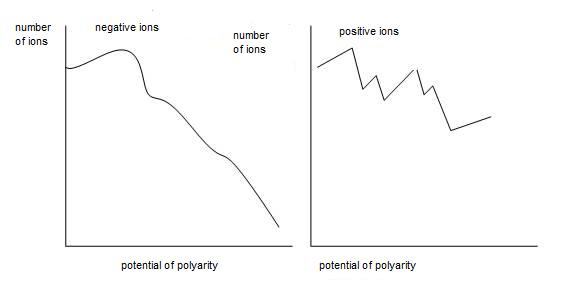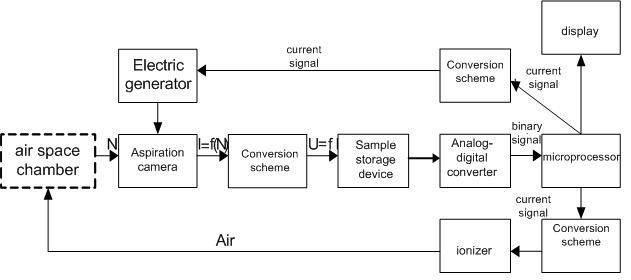
En
Avramenko
Svetlana
Faculty of Computer Information Technology and Automatic
Department of Electronic Engineering
Speciality: Scientific, analytical, environmental equipment and systems
Subject graduation work:
Design and rationale for the structure of the device controls the degree of ionization in the room
Supervisor: Burkivchenko Vladimir Ivanovich
| Masters portal of DonNTU |
Abstract
Introduction
Airoions observe physiologically unfavorable situation in modern residential, business and public auditories. Particular danger presents the work of many technical devices (such as computers or elektrocopyes), and processes that can create significant airoions anomalyes. Particularly strong danger of unfavorable conditions have people with impaired health and medical personnel for a long time is in the X-ray and physiotherapy facilities.
Physiologically airoions unfavorable situation characterized by relatively low (less than 200 ion/cm3) concentration of light negative airoins, large concentrations of small positive aeroions (500 ion/cm3) and heavy aeroions (1000 ion/cm3 of each polarity). There is value dynamic environment, and state environmental factors such as temperature and humidity. Timely and efficient correction environment possible by using special technical devices - airoionizators, optimization of ventilation and location of man-made sources of local ionization modes of production processes [1].
Airoions able provide strong physiological effect on human body and used in the treatment and prevention of many diseases, so modern official medicine recognizes the needing for air ionization in places where people live and work. Ionization defect at the negative impact on the health: a permanent anoxia impairs health, headaches, depression, increased fatigue, loss of attention and, consequently, to lower efficiency. In addition, it ireduces immunity, which provokes the development of various diseases. Making a list of the ionizer, which have solved this problem by increasing the number of negative airoions indoors, and improve air quality in this way, enable fully breathe, reduce fatigue, give care and longelivity.
But many studies show that existing data on the actions of negative ions on productivity inconsistent and contradictory [2]. Therefore, it appears that even impossible to prove definitely that the generation of negative ions provides real benefits that a large number of negative ions is unambiguously positive impact on human health. Experts do not recommend the use of ionizers in the following cases:
- The presence of malignant neoplasms. Airoions produced ionizers, enhance metabolism, which could lead to faster development of cancer [3];
- With a high body temperature. Speeding up metabolism can lead to temporary impairment of health of the patient;
- In very dusty and smoky room. Electrifiable dust particles and penetrate deeper in the lungs;
- In case intolerance [4, 5].
Analysis of the literature
Addressing the contemporary literature on this subject, found a few devices, which are directed mainly for registration only the number of light airoions, assuming all ions have the same charge, calculated the total number of particles [1, 2, 3, 4, 5, 6, 7]. Also, please keep in mind that these devices also have limitations due to the influence of other factors such as humidity and static electric field. Thus, these devices do not provide the necessary picture of air quality.
In addition, existing devices do not meet modern requirements:
-
control norms of ionization degree should be related to physiological characteristics of an organism;
-
availability ionizer in the room leads to gradual changes in the concentration of ions, which should record more than once, and considering this dynamic;
-
should be easy to use.
Statement of the problem
Airoions adjustment situation requires measuring airoions. Airoions active research, as part of atmospheric electricity began more than a century ago, as a result achieved significant theoretical and practical results. However, to date, such measurement is not enough implemented in practice because the technical, operational and cost characteristics of known airionometer-production does not fully meet modern requirements [8].
Norms of ionization already approved and proved the need to monitor their compliance. But the control over the ionization remains open and still unresolved, so there is a need to consider exactly this problem.
Measurements of ionic state of any substance is to find the number of particles, namely: positive, neutral and negatively charged ions. By setting the control should take the degree of ionization of air, which is defined as the ratio of ionized particles n the total number of particles N:

![]() . (1)
. (1)
You must measure the concentration of ions of positive and negative polarity, and output degree of ionization in the room. So degree of ionization in this case is the coefficient of unipolyarity:
 (2)
(2)
where n p - the number of negatively charged particles,
and n n - number of positively charged particles.
Development of the structural scheme and the principle of the device
To describe the state of ions in the air is not just enough to know the percentage of their presence in the air, because air ion properties define as properties of most ions. We should not measure the electrical conductivity of air, appreciating by ion composition and concentration measurements do most ions. And this, in our opinion, is the only valid and accurate method of measuring ions.
So you can put the specific requirements for the device being developed:
-
Measurement of negative and positive ions polarities simultaneously.
-
Finding coefficient unipolyarity.
-
Coll time delay device to a minimum.
-
Checking data accuracy for compliance and the possibility of adjustments.
-
Power unit will branch from the voltage and can also be powered by batteries (in this case to deduce information about the status of the battery and prevent its discharge to the indication).
-
Choice mode.
-
Availability of digital indication.
-
Sampling, processing and storage by microprocessor unit.
-
The possibility of communication with the PC.
-
Protection unit of the most important external influences of environment.
-
Ability to assess performance and identify damage, and the possibility of fast and quality working again.
Possibility of connection with the ionizer and revision of his work.
Main part
The device is based on ionization method, principle of action focused on the properties of most ions [9]. One of these properties is the ion mobility. Ion mobility can be found by number of ions depending polarizing potential applied to the ionization chamber. Characteristic curve for the positive ions differs from the curve for negative ions (see Fig. 1). Characteristic for negative ions is a continuous curve, while a distinctive feature of the characteristics of positive ions is that it is a series of straight lines with points of breakdown, at certain values of the polarization potential (discrete mobility). You can distinguish between three different groups of positive ions with the corresponding mobility 0.42, 0.84 and 2.5 cm2/(s*c). Therefore, when developing the method of calculation of the number of particles should take this option for the study mobility particles.

Fig. 1. Characteristic curves of ions of different polarities
The air contains the ions through mouth in ionization chamber (ionization chamber can be like a capacitor) a small fan. On the outer cover capacitor voltage is applied, which is the same polarity with the sign of the measured ions. The second cover of this second capacitor connected battery terminal. As a result, unambiguous (External facing) ions sit down on the measuring electrode and create a voltage drop at the measuring resistance. Oppositely charged ions sit down on foreign taxation and will not be based counters.
Voltage drop at the measuring resistance voltmeter is recorded electronically:
![]() , (3)
, (3)
where I - current through the measuring resistance, A
R - measuring resistance, Ohm,
e - elementary charge ion (1.6 * 10 -19 coulomb)
n - concentration of ions - the number of ions in cubic centimeters,
Ф - volume of air per second passed through the device, cm3/sec.
So voltmeter directly can show the concentration of ions n, that is able to scale the concentration of ions counted in cm 3 / sec. The formula is given above is true in the measurement of ion mobility which is greater than or equal to the limit. Extreme mobility of ions is expressed by:

 (4)
(4)
where C - is comparison of capacitor, IF
U - voltage on the external obkladtsi, V.
All ions with mobility of more K will be caught and taken into account. Setting at a capacitor voltage U, can catch ions with the selected limit mobility. Obviously, to take account of other ions sign we must add two more electrodes.
In this case the ionization chamber can be viewed as the aspiration capacitor (see Fig. 2) with four electrodes, separated from each other [10]. After aspiration capacitor (Ak), which covers are applied to certain potential difference studied air. Since Ak - air capacitor, along which covers air blows, it can be used for the study of the charger.
![]()
Fig. 2. Scheme of aspiration capacitor Flash animation, 174 frames, looped repetition, 7Kb
Ion mobility k - drift velocity of ions under electric field strength in tension E, equal units:
![]()
 (5)
(5)
where u - velocity of ions, cm^2/V*s.
Ions trapped in the air stream are moved along with the flow and simultaneously shifting in the electric field, settling on the appropriate taxation capacitor, leading to changes in potential difference between facing investigation. This study Ak discharge rate that occurs through variable resistance at the input and by ion deposition. In the case of charged particles in the air discharge occurs more rapidly than in their absence. As the number of charged particles in the studied stream, the more steep curve will discharge. A comparison of curves allows to determine discharge current of ions in the measurement capacitor, and then their concentration.
The principles of research enables simultaneous measurement of concentrations of ions of the entire spectrum of mobility to a certain limit [11]. Extreme mobility of k' calculated by the formula:
 (6)
(6)
where Vpros - air speed through the measuring capacitor that covers the width d and length L is the applied voltage V. All ions of air flow, mobility equal to or larger k ', caught capacitor and create in it current saturation. Lower mobility ions caught only partially.
Thus, as the capacitor discharge voltage between the cover decreases, and mobility of large ions caught.
Calculate the concentration of ions produced by the formula:
![]()
 (7)
(7)
where Cc - total capacity condenser, voltmeter and leaders
dV - modified cover potential between the capacitor during t,
q - ion charge,
w - Volumetric rate of blowing air.
Based on the above arguments, you can make a diagram of the device control the degree of ionization and put the specific requirements for the blocks. Structure of the device shown in Fig. 3:

Fig. 3. Block diagram of control device at the degree of ionization
Suction chamber is a unit consisting of their own aspiration ion chamber, located first in the direction of air movement and a sensor device and fan. Fan is designed to study air space chamber.
The device will be directly related to the ionizer, which facilitates the task of controlling the ionization of air. Electromagnetic field generator submits charges to the electrodes, the result, ionized particles settle to the gathering electrodes. Aspiration camera signal is current, which depends on the number of ionized particles. Output current aspiration chamber should be in the range from 0 to 100 mA.
![]()
![]() . (8)
. (8)
Conversion scheme is designed to convert alternating current to direct current uniform signal in the range from 0 to 100 mA, as well as signal conversion in current signal voltage for normal operation of analog-digital converter that works with voltage signals. Transformation goes from the scheme in the signal range (0 .. 5):
![]()
![]() (9)
(9)
Sample storage device (SSD) applied to exclude error in measure dinamic signal.
Analog-digital converter (ADC), designed to convert analog signals into unified digital code. ADC resolution is 12.
The obtained information is processed, recorded, transmitted and stored by microprocessor unit.
The results of measurements after treatment are displayed on the display. Possible connection to a PC via USB port and connect to the ionizer.
Perfect description of the blocks allows for further development in the future, namely the drafting schematic circuit device.
Conclusions
Problem analysis show that a differential approach is necessary to assess the ion structure of air. This can make using ionization method that is aimed at taking into account individual properties of charged particles, namely, mobility, and presence gain unipolyarity. Given all the demands put diagram of the device control the degree of ionization in the room and set requirements for the blocks.
Unit, structural scheme proposed here differs from analogues that carries particles considering both polarities separately that achieved by two electrodes of different polarities to the aspiration chamber. It has the following advantages:
- Availability of microprocessor unit, which enables rapid processing of information and control of the ionizer.
- Availability of digital display, and communication with the computer, which improves operator.
The device can be used to manufacture microelectronic products (consisting of equipment for “clean room”), in computer classes in the halls of computing centers in the textile, printing industry, in places people stay (theaters, cinemas, shopping and exhibition centers, etc.) for monitoring of the normal condition of the premises with an artificial microclimate.
References:
1. Мещеряков А.Ю., Федотов Ю. А. Проблемы оценивания аэроионного состояния среды обитания. //Приборы и системы управления. 1998 № 11. С.75-79.
2. Чижевский А.Л., Аэроинизация в медицине. Труды ЦНИЛИ "Проблемы ионификации". Т. 3. Воронеж, 1934, с. 118 - 326 с.
3. Агафонов И. П., Девятых Г.Г. Масс-спектрометрический анализ газов и паров особой чистоты, М.1980.- 458 с.
4. Соколов А.П. Ионизация воздуха как биологический и терапевтический фактор. Курортное дело. № 1, 2. М., 1925.- 346 с.
5. Мещеряков А.Ю. Особенности создания и использования электроэффлювиальных генераторов отрицательных ионов кислорода воздуха. //Международная конференция по биомедицинскому приборостроению Биомедприбор-98. Тезисы докладов. М., 1998. С.155-156.
6. Мещеряков А.Ю. Метрологические аспекты исследования физических характеристик воздуха на объектах со средой обитания. //Медицинская техника. 1999. №1. С.43-46.
7. Чижевский А.Л . С.75-79 Ионизация воздуха как физиологически активный фактор атмосферного электричества. Доклад. Калуга, 1919.- 256 с.
8.Ф. Х. Туктагулов, Методика измерения легких аэроионов воздуха, КГТУ им. Туполева - 1986.- 40 с.
9. К. Л. Юан и Ву Цзян-Сюн, Принципы и методы регистрации элементарных частиц, М., 1963.- 236 с., перевод с английского, М., 1963 .- 236 с.
10. Ритсон Д., Экспериментальные методы в физике высоких энергий, пер. с англ., М., 1964.- 320 с.
11. Glaser D. A., Some effects of ionizing radiation on the formation of bubbles in liquids, «The Physical Review», 1952, v. 87, № 4.
12. Калашникова В. И., Козодаев М. С. Детекторы элементарных частиц. М., 1966.- 312 с. - [электронный ресурс] - http://proteincrystallography.org/detectors/
| Masters portal of DonNTU |
